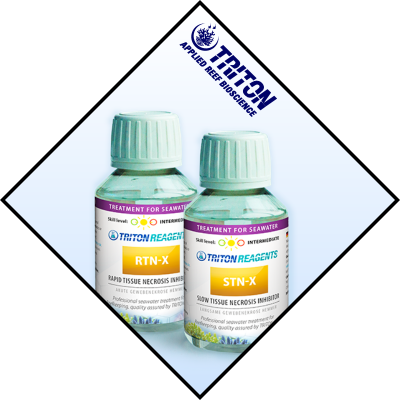- Joined
- Jul 31, 2019
- Messages
- 253
- Reaction score
- 231
RTN-X and STN-X
Slow Tissue Necrosis (STN) and Rapid Tissue Necrosis (RTN) are two common problems that have become increasingly prevalent in the modern reef aquarium with the growing popularity of small polyp stony coral (SPS) dominated systems. Although this issue can result from parasitic infestation, primary or secondary bacterial infection is another cause of tissue necrosis in our corals.
RTN-X and STN-X were derived through TRITON’s unique scientific work in N-DOC lab testing establishing the TRITON N : C : P Ratio. They can be used to aid corals against bacterial types of rapid tissue necrosis.
These products work to create an environment within the aquarium that shock the bacteria attacking the affected coral while, at the same time, providing specific elements that help to fortify the coral that is under attack. The shocking affect of this product is achieved by an intensive “in tank” bath which means that the infected coral does not need to be removed from the aquarium. A solution is prepared using the aquarium water in conjunction with either RTN-X or STN-X and after 20 minutes is ready for application. Minimize or stop water flow around the affected coral for maximum efficacy. If nutrient amounts are known, ideally through N-DOC testing, a very effective ratio adjustment can be administered prior to the intensive bath. Use our online calculator for optimal treatment information.
These products cannot prevent further deterioration of affected corals if the underlying stressors are not identified and addressed but will acutely treat the bacteria causing tissue necrosis.
Ideally used in conjunction with TRITON N-DOC lab tests to accurately dial in the dose rate, there is also a generic dose rate if exact water parameters are not available.
RTN-X and STN-X do not contain any from of antibiotic or aggressive heavy metals and are safe to use with any reef system.
Both products were designed in Australia and produced in Germany.

Slow Tissue Necrosis (STN) and Rapid Tissue Necrosis (RTN) are two common problems that have become increasingly prevalent in the modern reef aquarium with the growing popularity of small polyp stony coral (SPS) dominated systems. Although this issue can result from parasitic infestation, primary or secondary bacterial infection is another cause of tissue necrosis in our corals.
RTN-X and STN-X were derived through TRITON’s unique scientific work in N-DOC lab testing establishing the TRITON N : C : P Ratio. They can be used to aid corals against bacterial types of rapid tissue necrosis.
These products work to create an environment within the aquarium that shock the bacteria attacking the affected coral while, at the same time, providing specific elements that help to fortify the coral that is under attack. The shocking affect of this product is achieved by an intensive “in tank” bath which means that the infected coral does not need to be removed from the aquarium. A solution is prepared using the aquarium water in conjunction with either RTN-X or STN-X and after 20 minutes is ready for application. Minimize or stop water flow around the affected coral for maximum efficacy. If nutrient amounts are known, ideally through N-DOC testing, a very effective ratio adjustment can be administered prior to the intensive bath. Use our online calculator for optimal treatment information.
These products cannot prevent further deterioration of affected corals if the underlying stressors are not identified and addressed but will acutely treat the bacteria causing tissue necrosis.
Ideally used in conjunction with TRITON N-DOC lab tests to accurately dial in the dose rate, there is also a generic dose rate if exact water parameters are not available.
RTN-X and STN-X do not contain any from of antibiotic or aggressive heavy metals and are safe to use with any reef system.
Both products were designed in Australia and produced in Germany.

Last edited:











